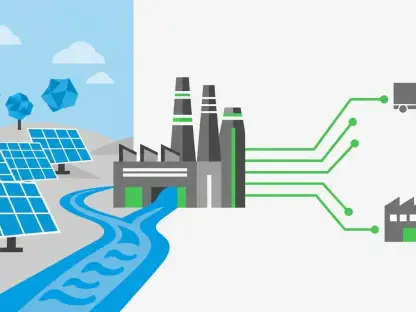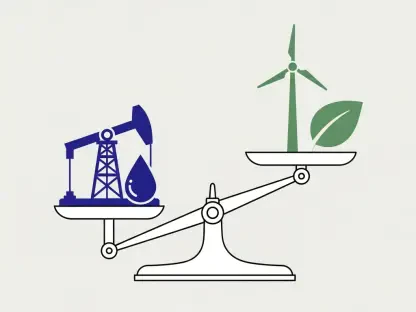Setting the Stage: A Pivotal Moment for U.S. Energy Markets
In the heart of 2025, the U.S. energy sector stands at a historic peak, with crude oil production reaching an unprecedented 13.41 million barrels per day (bpd), marking a triumph of technological innovation and operational efficiency. Yet, this achievement comes with an undercurrent of uncertainty as global oil markets grapple with volatile prices and shifting supply dynamics, raising the critical question: can this record output be sustained, or is a downturn inevitable? This analysis dives into the forces driving current production levels, the challenges on the horizon, and the broader implications for stakeholders across the energy landscape.
The importance of understanding these trends cannot be overstated. Oil remains a cornerstone of the U.S. economy, influencing everything from consumer prices at the pump to national energy security. With projections indicating a potential decline to 13.28 million bpd by next year, the stakes are high for producers, policymakers, and consumers alike. This market analysis aims to unpack the data, explore key drivers, and provide strategic insights into navigating this turning point.
Market Trends and In-Depth Analysis
Unpacking the Peak: Drivers of Record Production
The current surge in U.S. crude oil production to 13.41 million bpd is largely fueled by remarkable gains in well productivity, especially in shale-heavy regions like the Permian Basin. Advances in drilling techniques and extraction technologies have enabled operators to maximize output per well, even with a reduced number of active rigs. Data highlights that output per rig in key areas has risen significantly over recent years, showcasing the industry’s ability to adapt and thrive under varying market conditions.
This achievement, however, is not without its limits. The rapid pace of extraction raises concerns about the depletion of prime drilling locations, which could hinder long-term growth. Additionally, while technological improvements have bolstered efficiency, the reliance on high-performing wells means that any slowdown in innovation or investment could expose vulnerabilities. The balance between maintaining output and ensuring sustainability remains a delicate one for producers.
A further layer of complexity comes from domestic policy uncertainties. Fluctuations in regulations and potential shifts in tariffs can disrupt operational planning, impacting the ability to capitalize on current highs. As the industry celebrates this peak, the need to prepare for potential headwinds—both economic and political—becomes increasingly apparent.
Price Pressures: Forecasting a Decline Ahead
Looking toward next year, a projected drop in production to 13.28 million bpd is closely tied to an anticipated slump in oil prices. Brent crude, a global benchmark, is expected to average $51 per barrel in 2026, a notable decrease from earlier estimates. This decline is driven by increased output from OPEC+ nations, whose expanded supply quotas could oversaturate the market and suppress prices, directly affecting U.S. producers’ profitability.
Historically, low-price environments have forced American shale operators to scale back operations, as seen in past market downturns. Although current cost efficiencies provide some buffer, a sustained period of depressed prices could still lead to reduced drilling activity. This scenario underscores the sensitivity of U.S. production to global market dynamics and the need for agile financial strategies.
On the flip side, lower prices bring potential benefits for consumers. Retail gasoline prices are forecasted to dip below $2.90 per gallon next year, offering economic relief amid broader inflationary challenges. Yet, the risk of misjudging global demand—particularly if key economies slow down—could exacerbate oversupply issues, further pressuring domestic output levels.
Inventory Challenges: Distillate Shortages Loom Large
Another critical factor shaping the market is the state of U.S. distillate fuel inventories, which are at their lowest end-of-year levels since 2000. A 14% drop, attributed to strong export demand and domestic consumption, has strained stockpiles, with little recovery expected into next year. Reduced refinery capacity compounds the issue, limiting the ability to rebuild reserves quickly.
This tightness in distillate supplies—crucial for diesel and heating oil—poses risks of price volatility, particularly during high-demand seasons like winter. Regions such as the Northeast, historically vulnerable to heating oil shortages, could face elevated costs if supply constraints persist. The market’s inability to address these gaps swiftly highlights a structural challenge within the energy supply chain.
Efforts to mitigate these shortages through refining innovations or policy adjustments remain in early stages. Without coordinated action to prioritize domestic stock levels or curb export commitments, the potential for supply disruptions could cast a shadow over market stability, even as crude production reaches record heights.
Global and Geopolitical Influences: A Complex Web
Beyond domestic factors, global supply dynamics and geopolitical tensions play a significant role in shaping the U.S. oil market. Rising OPEC+ production levels add downward pressure on prices, while ongoing conflicts in regions like the Middle East and Ukraine introduce supply chain uncertainties. These external forces create a volatile backdrop against which American producers must operate.
U.S. oil demand, meanwhile, shows steady growth, reaching 20.4 million bpd currently and projected to edge up to 20.5 million bpd by next year. This resilience in consumption provides some counterbalance to production challenges, yet it also heightens the need for stable supply channels. Any unexpected disruptions abroad could either support domestic prices or deepen existing pressures, depending on their scale.
The interplay of these international factors with local market conditions illustrates the complexity of forecasting energy trends. Producers must remain vigilant, adapting to sudden shifts in global alliances or policy decisions that could alter the competitive landscape overnight.
Reflecting on the Past: Lessons and Strategic Pathways
Looking back, the journey to a historic crude oil production peak of 13.41 million bpd in 2025 revealed the U.S. energy sector’s remarkable capacity for innovation and adaptation. The subsequent forecast of a decline to 13.28 million bpd by 2026 underscored the fragility of such highs amid falling prices and global oversupply. Challenges like shrinking distillate inventories and geopolitical uncertainties further complicated the market outlook, painting a picture of an industry at a crossroads.
For energy firms, the path forward involves prioritizing cost efficiencies and strategic investments in drilling to weather potential price slumps. Policymakers must consider measures to bolster domestic refining capacity and manage export levels to stabilize critical stockpiles. Consumers, while poised to benefit from lower fuel costs, need to stay alert to regional supply risks that could disrupt this relief.
Moving ahead, stakeholders across the board are encouraged to monitor global supply decisions and geopolitical developments closely, adjusting strategies dynamically to mitigate risks. Exploring diversification into adjacent markets, such as renewable diesel, offers a hedge against crude price volatility. By embracing adaptability and forward-thinking policies, the industry can navigate past uncertainties toward a more resilient energy future.









